Beijing-Shanghai High-Speed Railway Bundle
Who Really Owns the Beijing-Shanghai High-Speed Railway?
Unraveling the ownership of the Beijing-Shanghai High-Speed Railway Company is key to understanding its strategic importance and financial performance. This high-speed rail line, a vital artery of China's transportation network, connects Beijing and Shanghai, two economic powerhouses. But who holds the reins of this critical piece of infrastructure, and how has that changed over time?
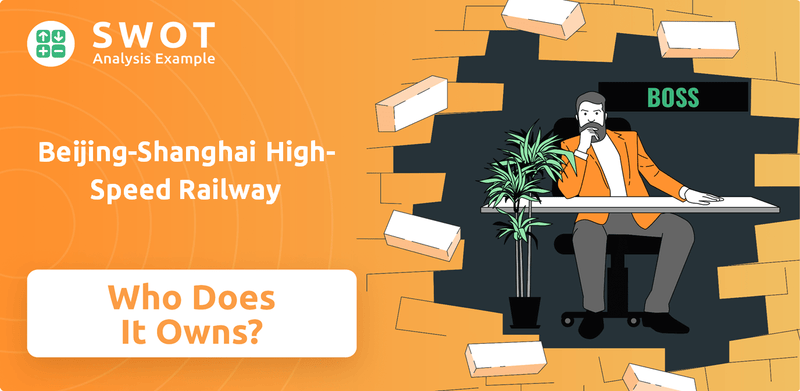
The Beijing-Shanghai High-Speed Railway, a cornerstone of China's railway infrastructure, has undergone a significant transformation since its inception in 2007. The initial public offering (IPO) in January 2020 marked a turning point, allowing public investors to participate in the success of this critical transportation link. Understanding the current ownership structure, including major shareholders and the influence of Beijing-Shanghai High-Speed Railway SWOT Analysis, is crucial for anyone interested in the Chinese transportation sector and the performance of CRH trains.
Who Founded Beijing-Shanghai High-Speed Railway?
The Beijing-Shanghai High-Speed Railway Co., Ltd. was established in 2007 as a state-owned enterprise. Its primary purpose was to raise funds for the ambitious Beijing-Shanghai High-Speed Railway project, a critical piece of Chinese transportation infrastructure. The initial funding strategy involved a mix of state investment, local government contributions, share offerings, bank loans, and foreign investment, marking a novel approach for railway projects at the time.
The project's estimated initial cost was ¥220 billion, equivalent to $32 billion by July 2008. The newly formed company aimed to secure ¥110 billion of this amount. The remaining funds were to be sourced through various channels, including foreign investment, a first for such a large-scale railway project. Ultimately, the total investment in the project reached ¥217.6 billion, or $34.7 billion.
The early ownership structure of the Beijing-Shanghai High-Speed Railway was heavily dominated by state-owned entities. While specific founders and their individual equity stakes are not publicly detailed, China Railway Corporation (now China State Railway Group) held a significant stake, reported as 46% before the IPO. Other key early stakeholders included Ping An Asset Management and a national social security fund, which collectively held a combined 20% ownership before the public listing. Tianjin Railway Construction Investment Corp Ltd was also an early shareholder. These early investments were crucial for financing the massive construction of the high-speed railway.
The early ownership of the Beijing-Shanghai High-Speed Railway was predominantly state-led, reflecting the strategic importance of the project. The initial funding of the project involved a mix of sources, including foreign investment, a first for a railway project. The state-led ownership structure ensured alignment with national strategic goals, facilitating the successful development of this critical infrastructure.
- China Railway Corporation (now China State Railway Group) held a significant stake, reported as 46% prior to the IPO.
- Ping An Asset Management and a national social security fund held a combined 20% ownership before the public listing.
- Tianjin Railway Construction Investment Corp Ltd was also an early shareholder.
- The project's initial cost was estimated at ¥220 billion ($32 billion) by July 2008, with ¥110 billion raised by the newly established company.
- The total investment in the project ultimately reached ¥217.6 billion ($34.7 billion).
The early ownership structure reflects the government's commitment to the project, ensuring that the development of this critical infrastructure aligned with national strategic goals. For more information, see Target Market of Beijing-Shanghai High-Speed Railway.
Beijing-Shanghai High-Speed Railway SWOT Analysis
- Complete SWOT Breakdown
- Fully Customizable
- Editable in Excel & Word
- Professional Formatting
- Investor-Ready Format
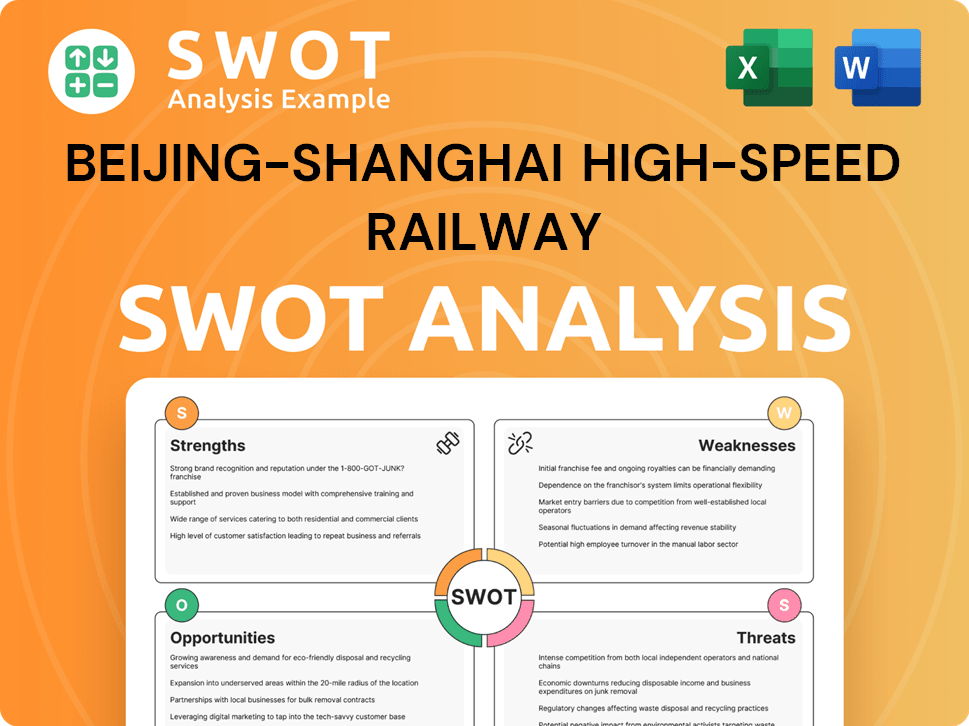
How Has Beijing-Shanghai High-Speed Railway’s Ownership Changed Over Time?
The ownership structure of the Beijing-Shanghai High-Speed Railway has evolved significantly since its inception. A pivotal moment in its history was the initial public offering (IPO) in January 2020. This move, which saw the company offer approximately 12.8% of its total equity, was a strategic step toward diversifying ownership and optimizing the capital structure within China's railway sector. The IPO raised around 30.7 billion yuan (about $4.46 billion), marking a substantial shift in the company's financial landscape and ownership dynamics.
The transition to a publicly listed entity reflects a broader trend in China towards 'asset securitization' and reducing corporate debt within state-owned enterprises. This shift, combined with the involvement of public and institutional investors, aims to diversify capital sources and enhance operational efficiency. The evolution of High-Speed Railway ownership also aligns with the broader goals of modernizing China's railway infrastructure and improving the overall efficiency of its transportation networks, as highlighted in the Growth Strategy of Beijing-Shanghai High-Speed Railway.
| Shareholder | Percentage of Shares | Approximate Number of Shares |
|---|---|---|
| China Railway Investment Group Co., Ltd. | 43.6% | 21,306,477,996 |
| Private Equity Firms | 43% | - |
| Private Companies | 23.2% | - |
| General Public | 17% | - |
| Institutions | 8.51% | 4,161,172,434 |
| Sovereign Wealth Funds | 6.26% | 3,062,225,309 |
| Ping An Asset Management Co., Ltd. | 6.61% | 3,245,958,828 |
| Jiangsu State-Owned Assets Supervision & Administration Commission | 4.775% | 2,344,607,848 |
As of February 2025, the major stakeholders of the Beijing-Shanghai High-Speed Railway Co., Ltd. include China Railway Investment Group Co., Ltd., which remains the largest shareholder with 43.6% ownership. Private equity firms collectively hold a substantial 43% stake, indicating their influential role. The general public holds a 17% stake, and institutions own 8.51% of the shares. Sovereign Wealth Funds and Ping An Asset Management Co., Ltd. are also significant shareholders, with 6.26% and 6.61% ownership, respectively. These figures highlight the diverse ownership structure and the blend of state control and private investment in this crucial piece of Chinese transportation infrastructure.
The Beijing-Shanghai High-Speed Railway's ownership structure is a mix of state and private entities.
- China Railway Investment Group remains the largest shareholder.
- Private equity firms and the general public hold significant stakes.
- The IPO in 2020 was a key event in diversifying ownership.
Beijing-Shanghai High-Speed Railway PESTLE Analysis
- Covers All 6 PESTLE Categories
- No Research Needed – Save Hours of Work
- Built by Experts, Trusted by Consultants
- Instant Download, Ready to Use
- 100% Editable, Fully Customizable
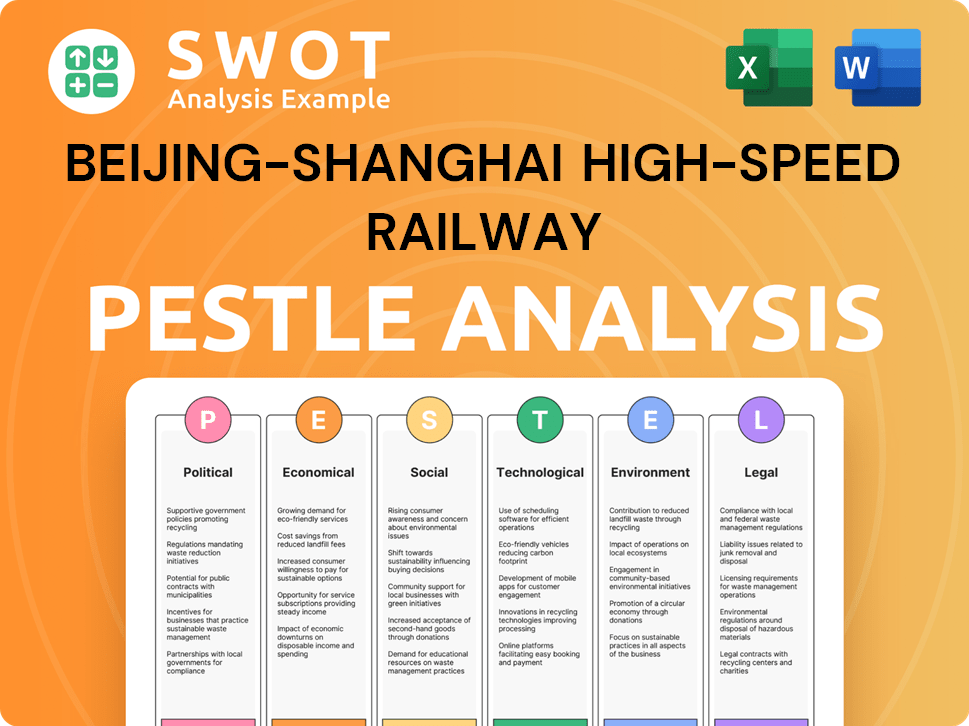
Who Sits on Beijing-Shanghai High-Speed Railway’s Board?
The composition of the Board of Directors for the Beijing-Shanghai High-Speed Railway Company isn't fully detailed in public records as of June 2025. The board's role is critical in the company's governance. The average tenure of the board members is about 2.5 years, suggesting a relatively new board. This information is essential for understanding the company's management structure and how it affects Marketing Strategy of Beijing-Shanghai High-Speed Railway.
Given the substantial ownership by state-owned entities and private equity firms, it's likely that representatives from these major shareholders hold key board positions. China Railway Investment Group Co., Ltd. owns 43.6%, and private equity firms hold another 43%. Regular governance activities are evident through announcements about board resolutions and annual general meetings, such as those on April 30, 2024, and December 26, 2024. There is no information available about recent proxy battles or activist investor campaigns.
| Board Aspect | Details | Status |
|---|---|---|
| Board Composition | Not fully detailed publicly | Ongoing |
| Average Tenure | Approximately 2.5 years | Current |
| Major Shareholders Representation | Likely present | Implied |
The significant shareholding by entities like China Railway Investment Group Co., Ltd. and private equity firms implies considerable voting power and influence over strategic decisions. The exact voting structure isn't explicitly stated. The company's management structure is influenced by its ownership, which impacts its financial performance and strategic direction. Understanding the board's composition is crucial for anyone looking into the company's stock or investment potential.
The Board of Directors oversees the Beijing-Shanghai High-Speed Railway, with major shareholders influencing decisions. State-owned entities and private equity firms hold significant stakes. The board's role is key to the company's operations.
- Board composition not fully disclosed.
- Average board tenure is around 2.5 years.
- Major shareholders likely have board representation.
- Voting power is heavily influenced by ownership structure.
Beijing-Shanghai High-Speed Railway Business Model Canvas
- Complete 9-Block Business Model Canvas
- Effortlessly Communicate Your Business Strategy
- Investor-Ready BMC Format
- 100% Editable and Customizable
- Clear and Structured Layout
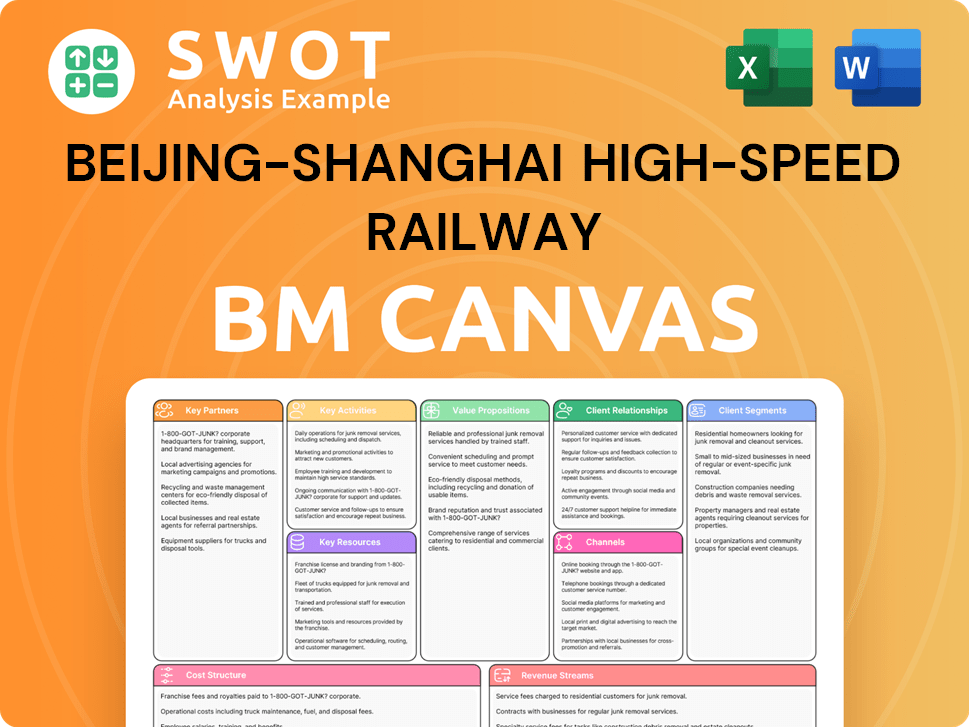
What Recent Changes Have Shaped Beijing-Shanghai High-Speed Railway’s Ownership Landscape?
Over the past few years, the Beijing-Shanghai High-Speed Railway has undergone significant changes in its ownership structure. The 2020 IPO was a pivotal moment, raising approximately $4.46 billion by selling 12.8% of its shares. This move aimed to support asset securitization and reduce debt for China Railway Corp (now China State Railway Group). Following the IPO, the company has actively repurchased shares. In April 2025, the company completed a buyback of 180.8 million shares, representing 0.37% of its total shares, for roughly CNY 999.49 million. Additionally, in March 2024, it completed the repurchase and cancellation of 1,566,166 restricted shares.
Ownership trends show an increase in institutional ownership, alongside the continued presence of private equity firms. As of February 2025, these firms collectively hold a substantial 43% stake. While China Railway Investment Group Co., Ltd. remains the largest shareholder with 43.6%, the IPO diversified the shareholder base to include general public investors (17%) and various institutions (8.51%). The company's financial health remains robust, with a net profit of 12.7 billion CNY in 2024, a 10.6% increase year-over-year from 2023. Operating income also saw a 4% rise in 2024. For more information on the railway's background, you can read a Brief History of Beijing-Shanghai High-Speed Railway.
There are no announced plans for future ownership changes or privatization beyond its current status. The company's focus seems to be on optimizing its capital structure and potentially acquiring other railway projects, as indicated by its pre-IPO prospectus, which mentioned plans to acquire a majority stake in the Anhui branch of the Beijing-Fuzhou High-speed Railway. This focus aligns with broader trends in Chinese transportation infrastructure.
China Railway Investment Group Co., Ltd. holds the largest share, at 43.6%. Institutional investors hold a significant portion of the shares. General public investors also have a notable stake in the company.
Net profit in 2024 reached 12.7 billion CNY, reflecting a 10.6% increase from 2023. Operating income saw a 4% increase in 2024. The company's financial performance remains strong, driven by efficient operation of CRH trains.
In April 2025, the company completed a buyback of 180.8 million shares. The buyback represented 0.37% of total shares. The cost of the buyback was approximately CNY 999.49 million.
The company may focus on optimizing its capital structure. There are potential acquisitions of other railway projects on the horizon. No immediate plans for privatization or major ownership changes have been announced.
Beijing-Shanghai High-Speed Railway Porter's Five Forces Analysis
- Covers All 5 Competitive Forces in Detail
- Structured for Consultants, Students, and Founders
- 100% Editable in Microsoft Word & Excel
- Instant Digital Download – Use Immediately
- Compatible with Mac & PC – Fully Unlocked
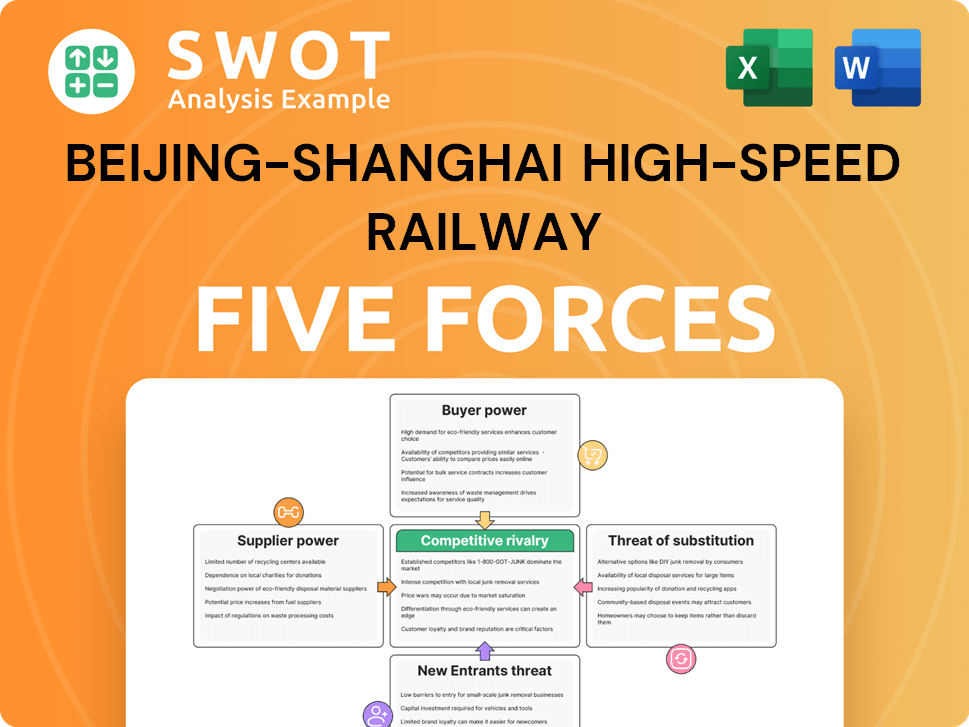
Related Blogs
- What are Mission Vision & Core Values of Beijing-Shanghai High-Speed Railway Company?
- What is Competitive Landscape of Beijing-Shanghai High-Speed Railway Company?
- What is Growth Strategy and Future Prospects of Beijing-Shanghai High-Speed Railway Company?
- How Does Beijing-Shanghai High-Speed Railway Company Work?
- What is Sales and Marketing Strategy of Beijing-Shanghai High-Speed Railway Company?
- What is Brief History of Beijing-Shanghai High-Speed Railway Company?
- What is Customer Demographics and Target Market of Beijing-Shanghai High-Speed Railway Company?
Disclaimer
All information, articles, and product details provided on this website are for general informational and educational purposes only. We do not claim any ownership over, nor do we intend to infringe upon, any trademarks, copyrights, logos, brand names, or other intellectual property mentioned or depicted on this site. Such intellectual property remains the property of its respective owners, and any references here are made solely for identification or informational purposes, without implying any affiliation, endorsement, or partnership.
We make no representations or warranties, express or implied, regarding the accuracy, completeness, or suitability of any content or products presented. Nothing on this website should be construed as legal, tax, investment, financial, medical, or other professional advice. In addition, no part of this site—including articles or product references—constitutes a solicitation, recommendation, endorsement, advertisement, or offer to buy or sell any securities, franchises, or other financial instruments, particularly in jurisdictions where such activity would be unlawful.
All content is of a general nature and may not address the specific circumstances of any individual or entity. It is not a substitute for professional advice or services. Any actions you take based on the information provided here are strictly at your own risk. You accept full responsibility for any decisions or outcomes arising from your use of this website and agree to release us from any liability in connection with your use of, or reliance upon, the content or products found herein.